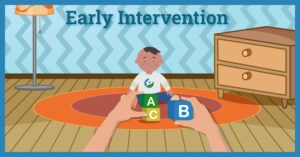
This blog article is part of a series dedicated to Autism Awareness Month. To read the previous article in the series, haga clic aquí!
Receiving an official diagnosis of autism spectrum disorder (ASD) for your child is the first step toward early intervention, but many parents are unsure what comes next. Before enrolling in autism therapy or signing up for an early intervention program, it’s important to understand the specific challenges your child is facing and how they impact their long-term development.
Every child diagnosed with autism has different developmental and treatment needs. Although there is often some overlap, your child’s autism treatment plan will be unique, tailored, and adaptable. This ensures mental health specialists and autism therapy providers can keep pace with your child’s growth and update their treatment plan as new skills are mastered – but before we dive into early intervention programs and practices, let’s quickly revisit autism screening and diagnosis.
Autism Screening and Diagnosis
Once you feel confident that your child may have autism, you will want to reach out to your pediatrician to discuss speech and cognitive development. Be prepared to answer questions regarding your child’s behavior, especially as it relates to the common signs of autism. Additionally, you should be prepared to answer other questions about your child’s behavior, such as how many tantrums your child has per day, how long your child’s tantrums last, and how proficient your child’s communication is for their age. If your pediatrician feels that your child’s development curve matches the early signs of autism, you should request an autism screening.
Receive an autism screening
An autism screening can be requested at any time from your pediatrician, or from an early intervention program provided by your state. These screenings can be as simple as a parent questionnaire or a brief observation session with your child. Your pediatrician will ask about your child’s development, including their overall behavior, language use, cognitive abilities, physical movement, emotional regulation, and critical thinking. The American Academy of Pediatrics (AAP) recommends that autism screenings be performed at 9 months, 18 months, and 30 months, with extra screening to be done if there is elevated concern.
Request an autism assessment
If your pediatrician observes behaviors associated with autism during the developmental screening, you can then be referred to a specialist for a diagnostic evaluation. These more in-depth autism assessments are performed by child neurologists and pediatric psychologists, who use a variety of diagnostic tools to identify and evaluate ASD. According to the Centers for Disease Control and Prevention, the most common autism evaluation tools include:
-
Autism Diagnosis Interview: This clinical diagnostic tool focuses on behavior in three key areas – reciprocal social interaction, communication and language, and restricted/repetitive stereotyped interests and behaviors.
-
Autism Diagnostic Observation Schedule: Consisting of four 30-minute assessment modules, this diagnostic approach looks at social interaction, communication, play, and the imaginative use of materials.
-
Childhood Autism Rating Scale: A brief evaluation for children over 2 years old that uses multiple approaches from other autism assessment tools, focusing on behavior, cognitive ability, and socialization.
Children who receive an ASD diagnosis through these or other autism evaluation tools will need some degree of extra support as they approach preschool age. The level of support and treatment each child needs is based on their unique challenges and developmental milestone delays. Some children with ASD may only need help with language and communication skills, while others will require years of ABA therapy to build key daily functioning skills.

Autism Early Intervention: Key Resources
The first step in early intervention is to work with your pediatrician or specialist to locate support systems and resources in your local area. Most states have early intervention programs for children with autism, which provide a wealth of information about ASD, autism therapies, and early intervention best practices. It can also be helpful to network with other parents who have children with autism and to join online support groups to learn how other families have helped their children excel.
To help get you started, here are a few useful online resources for autism early intervention:
-
Autism Speaks 100 Day Kit: This free tool kit is filled with critical information that can help parents navigate the first 100 days after their child receives an autism diagnosis. Learn more about ASD, autism therapy options, and how to help your child develop key functional skills.
-
Family Voices: This non-profit organization provides support, information, resources, and training to families with special needs children. Through Family Voices, you can learn about publicly available services and programs related to autism therapy and early intervention.
-
Association for Science in Autism Treatment (ASAT): ASAT publishes detailed information about the research behind many of the common treatments for individuals with ASD, including speech therapy, occupational therapy, and applied behavior analysis.
Autism Early Intervention Methods
Early intervention for autism is all about helping children gain basic skills that most learn in the first two years of life. This includes physical skills, cognitive abilities, communication, social skills, and emotional regulation. According to research compiled by the National Institute of Child Health and Human Development (NIH), early diagnosis and intervention for autism can have major, long-term positive effects on symptoms and overall behavior.

Generally speaking, the sooner a child gets help, the greater the chance for learning and progress – recent guidelines recommend starting behavioral intervention as soon as ASD is diagnosed. Of course, there are many different intervention methods and treatments available for children with ASD. As the CDC points out, these treatments can be broken down into categories of approaches, such as:
-
Behavioral: Focuses on changing behaviors by building a perception of the behavior before and after it happens. This category has the most scientific evidence to support it and has been shown to be the most effective. This category includes Terapia ABA.
-
Developmental: Focuses on developing skills related to early development, such as communication and motor skills. This is often used in conjunction with behavioral approaches. This category includes speech and language therapy. It also includes sensory integration therapy and physical therapy, which fall under the umbrella of occupational therapy.
-
Educational: Focuses on creating a classroom setting where consistency and visual learning are prioritized. This approach includes Treatment and Education of Autistic and Related Communication-Handicapped Children, or TEACCH, which provides teachers with ways to adjust the classroom structure and improve academic and other outcomes.
-
Social-relational: As the name implies, this approach focuses on social skills and the development of interpersonal relationships. There are two models that fall under this approach. The first model is the Developmental, Individual Differences, Relationship-Based model, which encourages parents and therapists to follow the interests of the individual to expand opportunities for communication. The second model is the Relationship Development Intervention model which involves activities that increase motivation, interest, and abilities to participate in shared social interactions.
-
Pharmacological: There are no dedicated medications that are proven to treat the core symptoms of ASD. However, there are some medications that can help to reduce the effects of co-occurring symptoms such as inability to focus, excess energy, or even self-harming behavior. Consult your doctor before considering any kind of medication for your child.
-
Psychological: Focuses on coping with psychological conditions that can be caused by or related to ASD, such as depression, anxiety, or other issues. This approach includes Cognitive-Behavior Therapy or CBT, which employs connections between feelings, thoughts, and behavioral habits. It is a goal-oriented therapy that is meant to challenge the perception of situations and the way we react to them.
Getting the Help Your Child Needs
Once you’ve received an ASD diagnosis and explored early intervention options, the next step is to figure out which autism therapy is right for your child. Work alongside your pediatrician and neurologist (or another specialist) to determine which skills groups your child needs the most help with, and whether ABA therapy may be right for you.
ABA therapy is considered the ‘standard of care’ for children with autism by most health institutions, including the American Academy of Pediatrics, American Psychological Association, Society for Developmental and Behavioral Pediatrics, and even the U.S. Surgeon General. To learn more about the benefits of ABA therapy, check out this informational ABA overview.
This blog article is part of a series dedicated to Autism Awareness Month. To read the next article in the series, click here!
Sources:
https://publications.aap.org/aapnews/news/7042
https://www.autismspeaks.org/tool-kit/100-day-kit-young-children
https://asatonline.org/research-treatment/
https://www.nichd.nih.gov/health/topics/autism/conditioninfo/treatments/early-intervention



